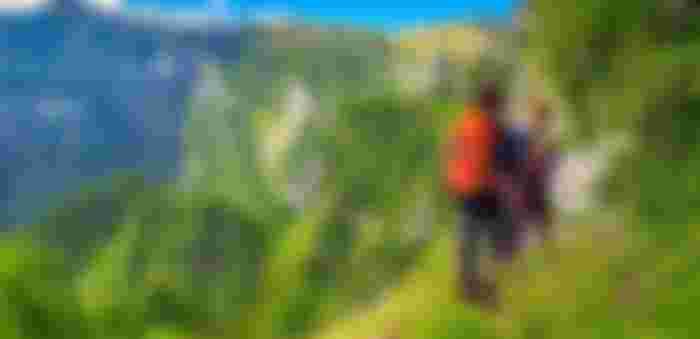A Comprehensive Travel Guide of Uttarakhand's Valley of Flowers

Introduction:
Uttarakhand's Phoolon Ki Ghati (also known as the Valley of Flowers) is one of the state's most beautiful and captivating places. With the majestic Himalayan mountains as its gorgeous background, Uttarakhand's Valley of Flowers spans an area of 87 square kilometers in the Chamoli District.
Mountaineer Frank S Smith discovered this heavenly haven in 1931 while returning from an expedition to Mount Kamet. Flowering alpine meadows await you in this nature's gift, because of this, including the Valley of Flowers on your Uttarakhand travel itinerary.
In addition to the valley, the Pushpawati River, dense woods, cliffs, beautiful glaciers, and flowing waterfalls contribute to the breathtaking scenery. You'll be drawn here if you enjoy photography, birdwatching, hiking, and village strolls.
The valley is home to a number of endangered animals, including the Asiatic black bear, musk deer, snow leopard, red fox, brown bear, and blue sheep, in addition to its unique and abundant vegetation. No surprise, the Indian National Park and UNESCO World Heritage Site in Uttarakhand are popular tourist destinations.
Let’s get started in detail!
1. Trekking
It's a superb location for hiking and mountaineering in the transitional zone between the magnificent Zanskar mountains and the eastern and western Himalayas. Govindghat is the starting point for the 17-kilometer walk. Stunning vistas of cascading waterfalls, lush vegetation, and the Himalayan ranges surround the trek. Ghangaria is a town located 14 km from Govindghat. On the approach to Uttarakhand's Valley of Flowers National Park, you pass through this little village, which is the last remaining human settlement.
2. Pilgrimage
Sri Hemkund Sahib Gurudwara, located at the height of 4,329 meters, translates to "lake of snow" in Hindi. Additionally, tourists can hire porters, mules, or helicopters to visit the Sikh shrine at Hemkund Sahib in Uttarakhand. They consider it one of their most holy places and worship there with great devotion. With seven ice cap peaks around the crystal-clear lake, the trip to the valley of flowers in Uttarakhand is even more rewarding by the stunning reflection of majestic mountain ranges and stunning glaciers. Pilgrims and visitors from around the world go to this serene and attractive location.
3. Exploring The Streets Of A Small Town
To go to the Valley of Flowers, you must pass through Ghangaria, the last place where people still live. Along with Pushpawati River, Ramganga River also meets here. Previously, Lakshman Ganga River met here. While most of the year is covered in snow, it is recommended that you go between May and September. However, if you have a look at this lovely and peaceful hamlet, the effort will be well worth it. You may go for a hike, take a stroll around the village, or just observe nature and the environment for what it truly is.
Spectacular Floral Arrangements
Uttarakhand's Valley of Flowers is a well-kept secret, and looking at it is enough to make you fall in love with nature and everything it offers. As you go through the gardens, you'll be surrounded by more than 700 different kinds of flowers, from orchids to lilies to geraniums to zinnias to petunias, and you'll be in a natural baroque of flowers. The place has been called the "Center of Plant Diversity" for a reason. You'll also see a wide range of brightly colored butterflies flitting among the brightly colored flowers.
Watching the birds
In the Valley of Flowers, birdwatchers will have a field day! As a birdwatcher, you'll see a wide variety of unusual species, including the Himalayan golden eagle, snow pigeons, Himalayan monals, and sparrows, at this location.
Because it's only open from June to October, the best time to visit Uttarakhand's Valley of Flowers is at its peak bloom in July and early August. Listed below are some of the things you may expect in the following months:
>> June
Tiny buds and sprouts begin to form as the snow starts to melt and the seeds of the previous year's plants begin germinating. It's also a great time to see the Reinwardtia, Oxalis, Viola Pilosa, Fragaria Nubicola, and Thymus Linearis blooms in the Valley of Flowers in June. You can also see the Marsh Marigold and Berberis Aristata in the Valley of Flowers.
>> July
You can catch a glimpse of one of Uttarakhand's most enchanting vistas at this time. Many different kinds of flowers, such as Epilobium, will grow on a carpet beneath your feet. The Valley of Flowers, Uttarakhand, is best visited in July.
>> August
The Valley of Flowers is in full bloom until mid-August, and you'll be able to see a variety of flowers and butterflies, not to mention the breathtaking terrain and vistas. However, if you're planning a hiking trip, July to September is the finest period. The initial rains of the monsoon season had ceased at this point. You don't have to be concerned about the weather when arranging your adventure activities. However, winter is the worst time to visit the Valley of Flowers in Uttarakhand since the beautiful and verdant meadows are covered in snow, making your trip a waste of time.
Conclusion:
In addition to being a world heritage site, the Valley of Flowers serves as the gateway between the Himalayan ranges of the Western and Eastern Himalayas. Our chance to see a piece of heaven here on Earth is priceless. Full Ki Ghati in Uttarakhand, with its gleaming white glaciers, snow-covered hills, tumbling waterfalls, and serene lakes, isn't too far-fetched to call the essence of paradise.
